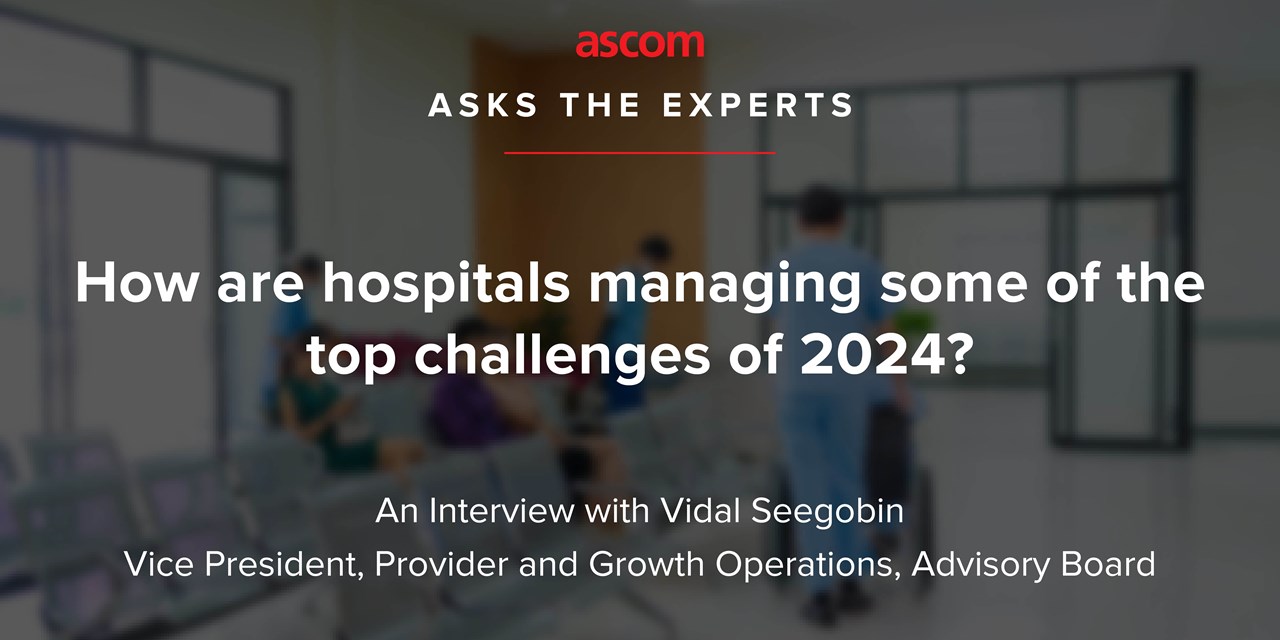Country selector

North America
Country Selector: North America
As we navigate the post-pandemic landscape, hospital CIOs and CNOs face unique challenges and opportunities. In a recent Ascom Asks the Experts interview, I talked with industry expert, Vidal Seegobin, Vice President, Provider Growth and Operations, Advisory Board. He highlighted several key strategic priorities and insights for 2024 and reported on hospitals’ progress against these imperatives.

Ascom Asks the Experts Interview with Vidal Seegobin, Vice President, Provider Growth and Operations, Advisory Board
By David Gutillo, Director, Field Market Innovation, Healthcare, Ascom Americas
As we navigate the post-pandemic landscape, hospital CIOs and CNOs face unique challenges and opportunities. In a recent Ascom Asks the Experts interview, I talked with industry expert, Vidal Seegobin, Vice President, Provider Growth and Operations, Advisory Board. He highlighted several key strategic priorities and insights for 2024 and reported on hospitals’ progress against these imperatives.
1. Leveraging Technology for Growth and Sustainability
One of the main themes we talked about focused on the critical role of technology in driving growth and sustainability. Despite financial improvements, hospitals are still struggling with productivity and staffing stability. Technologies such as pattern recognition, chatbots, and clinical documentation tools are emerging as valuable assets, particularly in non-clinical areas. These tools can help ease workflows, offset tasks, and improve overall productivity. However, he points out that while clinical technology implementations may be more difficult to implement that non-clinical ones, they can bring big long-term benefits.
“Every challenge offers itself an opportunity or a path to make sizable changes. As we are thinking about persistent workforce shortages and our more junior staff coming in this experience complexity gap, this is a ripe opportunity for us to do what we've always hoped to do, which is to use technology in in a way that is additive of productivity as opposed to a drag in productivity. And so what we were required to do that or to make that unlock is to think differently and unpack and repack workflows as opposed to simply overlaying technology and expecting it to, by definition or by application, improve that workflow.”
2. Innovative Financial Strategies
With many hospitals experiencing margins below 2022 levels, he stresses the importance of innovative financial strategies. Partnerships with technology companies for co-development and outcomes-based contracts are becoming more common, and these arrangements let hospitals optimize workflows and leverage technology without significant upfront capital expenditure.
3. Focus on Operational Efficiency
Increasing quality, workforce efficiency, and operational efficiency are top priorities. Hospitals are exploring ways to maximize existing resources due to CapEx constraints. Technologies that automate non-clinical tasks, such as revenue cycle management, are particularly appealing. These solutions can clearly demonstrate cost reductions and improved revenue capture. It’s also important to implement these solutions on the clinical side.
He explained, “The challenge is bringing people along, particularly clinicians, to trust and understand the technology and what it's doing and still allowing them for our clinicians to feel like they have autonomy and control over decisions and that these technologies are supportive, not supplanting their importance and the overall decision making tree for health care.”
4. Reducing Care Variation
We talked about care variation reduction’s role in improving margins and operational efficiency. Standardizing care processes ensures consistent outcomes across different sites and providers, yet there’s a lot of work to be done in this area.
“While everyone starts out learning what best practice is when they first enter into clinician work or medicine, over time, they develop their own heuristics, which means three doctors in three different sites might be delivering three different modalities of care for the same type of condition. What care variation says is that, can we collectively agree on a set of standards, activities and approaches for patients presenting with certain conditions such that regardless of whether or not the patient went to site A, B, or C, we could guarantee that they would receive the level of care that we would want them to.”
He noted the importance of this approach as hospitals deal with more complex patient populations and a growing number of junior clinicians. By implementing care variation standards, hospitals can enhance the performance of their staff and improve patient outcomes.
Going Forward
The imperatives we talked about for 2024 will continue to be common themes going forward into 2025 and beyond. By focusing on technology, innovative financial strategies, operational efficiency, and care variation reduction, hospitals can navigate the complexities and challenges to drive sustainable long term growth. To see the full conversation, watch the Ascom Asks the Experts interview on our website.